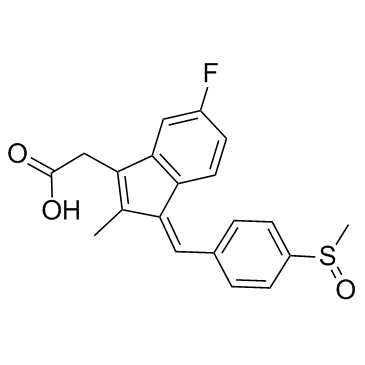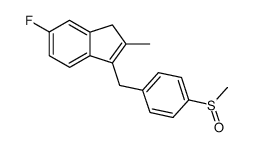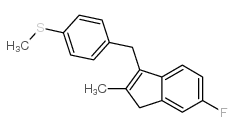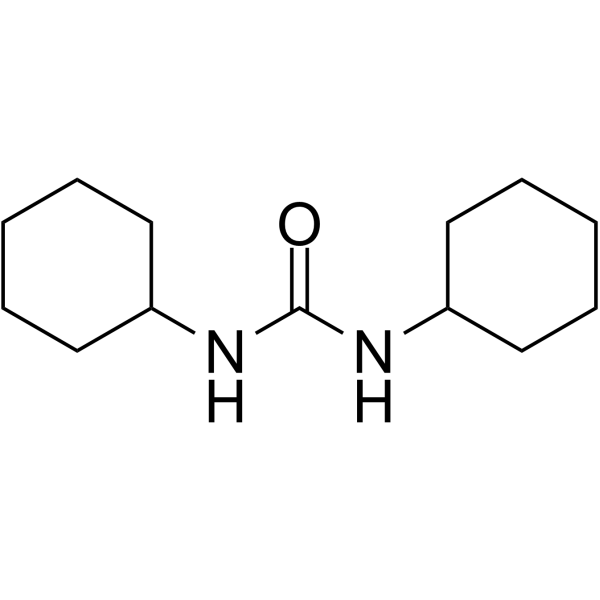Sulindac

Sulindac structure
|
Common Name | Sulindac | ||
|---|---|---|---|---|
| CAS Number | 38194-50-2 | Molecular Weight | 356.411 | |
| Density | 1.4±0.1 g/cm3 | Boiling Point | 581.6±50.0 °C at 760 mmHg | |
| Molecular Formula | C20H17FO3S | Melting Point | 182-185°C | |
| MSDS | Chinese USA | Flash Point | 305.6±30.1 °C | |
| Symbol |


GHS06, GHS08 |
Signal Word | Danger | |
Use of SulindacSulindac is a non-steroidal antiinflammatory agent, acts as a COX-2 inhibitor, and inhibits overexpression of COX-2. |
| Name | sulindac |
|---|---|
| Synonym | More Synonyms |
| Description | Sulindac is a non-steroidal antiinflammatory agent, acts as a COX-2 inhibitor, and inhibits overexpression of COX-2. |
|---|---|
| Related Catalog | |
| Target |
COX-2 Autophagy |
| In Vitro | Sulindac is a non-steroidal antiinflammatory agent, acts as a COX-2 inhibitor, and inhibits overexpression of COX-2[1]. Sulindac (0.1 mM to 0.5 mM) causes limited death in both p53 wt and p53 null HCT116 cells, but in combination with vitamin C, it dramatically increases almost 5-fold in cell death in p53 wt HCT116 cells relative to the vitamin C alone, and such an effect is involving caspase activation and p53 function in these cells, and via ROS-mediated pathway. Sulindac combined with vitamin C significantly increases PUMA levels, but shows no effect on Bim, Bcl-2 and Mcl-1 levels[2]. Sulindac (500 μM) in combination with celecoxib blocks transforming growth factor (TGF)-β1-induced epithelial-mesenchymal transition, migration and invasion in A549 cells. The combination also suppresses involvement of sirtuin 1 (SIRT1) in transforming growth factor (TGF)-β1-induced epithelial-mesenchymal transition (EMT)[3]. |
| In Vivo | Sulindac (0.5 ± 0.1 mg/day) decreases COX, modolates PGE2 levels and prevents tumor formation in the Min mice[1]. |
| Cell Assay | Cells are treated with Sulindac and/or vitamin C at the indicated doses for 48 h, and cell viability is analyzed using a trypan blue exclusion assay. For the annexin V staining assay, cells are treated with 0.5 mM Sulindac and/or 0.5 mM vitamin C for 48 h. The cells are then trypsinized, washed with PBS, stained with propidium iodide (PI) and FITC-labeled annexin V for 30 min, and analyzed by flow cytometry using a fluorescence-activated cell sorter[2]. |
| Animal Admin | Mice[1] Female C57BL16J-Min/+ (Min) mice at 5 weeks of age are used in the assay. Beginning at 5-6 weeks of age, 10 Min mice are fed a low-fat AIN-76A chow diet modified with 0.001% ethoxyquin and Sulindac, 0.5 ± 0.1 mg/day (0.05 mg/kcal/day or approximately 160 ppm) in drinking water. As controls, 9 Min mice and 5 C57BL/6J-+/+ non-affected littermates (+/+) are fed AIN-76A diet without Sulindac. Animals are checked daily for signs of distress or anemia. Animals and their food are weighed twice weekly. During the course of the experiment, there is no difference in body weight or food consumption among the various study groups. No toxicity is observed in the Min/Sulindac group. At 110 days of age, all mice are euthanized by CO2 inhalation, and their intestinal tracts are removed from esophagus to distal rectum, opened, flushed with saline, and examined under ×3 magnification to obtain tumor counts. Tumors are counted by an individual blinded to the animal's genetic status and treatment. Multiple samples of grossly normal, full-thickness bowel are harvested from the mid small intestine and either frozen in liquid nitrogen or fixed in 10% formalin for histological examination. All samples used for the analyses in this study are taken from mid small intestine[1]. |
| References |
| Density | 1.4±0.1 g/cm3 |
|---|---|
| Boiling Point | 581.6±50.0 °C at 760 mmHg |
| Melting Point | 182-185°C |
| Molecular Formula | C20H17FO3S |
| Molecular Weight | 356.411 |
| Flash Point | 305.6±30.1 °C |
| Exact Mass | 356.088257 |
| PSA | 73.58000 |
| LogP | 3.59 |
| Vapour Pressure | 0.0±1.7 mmHg at 25°C |
| Index of Refraction | 1.673 |
| InChIKey | MLKXDPUZXIRXEP-MFOYZWKCSA-N |
| SMILES | CC1=C(CC(=O)O)c2cc(F)ccc2C1=Cc1ccc(S(C)=O)cc1 |
| Storage condition | Store at RT |
|
Section1. IDENTIFICATION OF THE SUBSTANCE/MIXTURE Product identifiers Product name: Sulindac CAS-No.: 38194-50-2 Relevant identified uses of the substance or mixture and uses advised against Identified uses: Laboratory chemicals, Manufacture of substances Section2. HAZARDS IDENTIFICATION Classification of the substance or mixture Classification according to Regulation (EC) No 1272/2008 [EU-GHS/CLP] Acute toxicity, Oral (Category 3) Respiratory sensitization (Category 1) Skin sensitization (Category 1) Reproductive toxicity (Category 2) Classification according to EU Directives 67/548/EEC or 1999/45/EC Harmful if swallowed. Harmful if swallowed. May cause sensitization by inhalation and skin contact. Possible risk of harm to the unborn child. Label elements Labelling according Regulation (EC) No 1272/2008 [CLP] Pictogram Signal wordDanger Hazard statement(s) H301Toxic if swallowed. H317May cause an allergic skin reaction. H334May cause allergy or asthma symptoms or breathing difficulties if inhaled. H361Suspected of damaging fertility or the unborn child. Precautionary statement(s) P261Avoid breathing dust/ fume/ gas/ mist/ vapours/ spray. P280Wear protective gloves. P301 + P310IF SWALLOWED: Immediately call a POISON CENTER or doctor/ physician. P342 + P311If experiencing respiratory symptoms: Call a POISON CENTER or doctor/ physician. Supplemental Hazardnone Statements According to European Directive 67/548/EEC as amended. Hazard symbol(s) R-phrase(s) R22Harmful if swallowed. R42/43May cause sensitization by inhalation and skin contact. R63Possible risk of harm to the unborn child. S-phrase(s)none Other hazards - none Section3. COMPOSITION/INFORMATION ON INGREDIENTS Substances Synonyms: (Z)-5-Fluoro-2-methyl-1-[p-(methylsulfinyl)benzylidene]indene-3-acetic acid Formula: C20H17FO3S Molecular Weight: 356,41 g/mol ComponentConcentration Sulindac CAS-No.38194-50-2- EC-No.253-819-2 Section4. FIRST AID MEASURES Description of first aid measures General advice Consult a physician. Show this safety data sheet to the doctor in attendance. If inhaled If breathed in, move person into fresh air. If not breathing, give artificial respiration. Consult a physician. In case of skin contact Wash off with soap and plenty of water. Take victim immediately to hospital. Consult a physician. In case of eye contact Flush eyes with water as a precaution. If swallowed Never give anything by mouth to an unconscious person. Rinse mouth with water. Consult a physician. Most important symptoms and effects, both acute and delayed Indication of any immediate medical attention and special treatment needed no data available Section5. FIREFIGHTING MEASURES Extinguishing media Suitable extinguishing media Use water spray, alcohol-resistant foam, dry chemical or carbon dioxide. Special hazards arising from the substance or mixture Carbon oxides, Sulphur oxides, Hydrogen fluoride Advice for firefighters Wear self contained breathing apparatus for fire fighting if necessary. Further information no data available Section6. ACCIDENTAL RELEASE MEASURES Personal precautions, protective equipment and emergency procedures Wear respiratory protection. Avoid dust formation. Avoid breathing vapors, mist or gas. Ensure adequate ventilation. Evacuate personnel to safe areas. Avoid breathing dust. Environmental precautions Prevent further leakage or spillage if safe to do so. Do not let product enter drains. Methods and materials for containment and cleaning up Pick up and arrange disposal without creating dust. Sweep up and shovel. Keep in suitable, closed containers for disposal. Reference to other sections For disposal see section 13. Section7. HANDLING AND STORAGE Precautions for safe handling Avoid contact with skin and eyes. Avoid formation of dust and aerosols. Provide appropriate exhaust ventilation at places where dust is formed.Normal measures for preventive fire protection. Conditions for safe storage, including any incompatibilities Store in cool place. Keep container tightly closed in a dry and well-ventilated place. Specific end uses no data available Section8. EXPOSURE CONTROLS/PERSONAL PROTECTION Control parameters Components with workplace control parameters Exposure controls Appropriate engineering controls Avoid contact with skin, eyes and clothing. Wash hands before breaks and immediately after handling the product. Personal protective equipment Eye/face protection Face shield and safety glasses Use equipment for eye protection tested and approved under appropriate government standards such as NIOSH (US) or EN 166(EU). Skin protection Handle with gloves. Gloves must be inspected prior to use. Use proper glove removal technique (without touching glove's outer surface) to avoid skin contact with this product. Dispose of contaminated gloves after use in accordance with applicable laws and good laboratory practices. Wash and dry hands. The selected protective gloves have to satisfy the specifications of EU Directive 89/686/EEC and the standard EN 374 derived from it. Body Protection Complete suit protecting against chemicals, The type of protective equipment must be selected according to the concentration and amount of the dangerous substance at the specific workplace. Respiratory protection Where risk assessment shows air-purifying respirators are appropriate use a full-face particle respirator type N100 (US) or type P3 (EN 143) respirator cartridges as a backup to engineering controls. If the respirator is the sole means of protection, use a full-face supplied air respirator. Use respirators and components tested and approved under appropriate government standards such as NIOSH (US) or CEN (EU). Section9. PHYSICAL AND CHEMICAL PROPERTIES Information on basic physical and chemical properties a) AppearanceForm: solid b) Odourno data available c) Odour Thresholdno data available d) pHno data available e) Melting point/freezingno data available point f) Initial boiling point and no data available boiling range g) Flash pointno data available h) Evaporation rateno data available i) Flammability (solid, gas) no data available j) Upper/lowerno data available flammability or explosive limits k) Vapour pressureno data available l) Vapour densityno data available m) Relative densityno data available n) Water solubilityinsoluble o) Partition coefficient: n- no data available octanol/water p) Autoignitionno data available temperature q) Decompositionno data available temperature r) Viscosityno data available s) Explosive propertiesno data available t) Oxidizing propertiesno data available Other safety information no data available Section10. STABILITY AND REACTIVITY Reactivity no data available Chemical stability no data available Possibility of hazardous reactions no data available Conditions to avoid no data available Incompatible materials Strong oxidizing agents Hazardous decomposition products Other decomposition products - no data available Section11. TOXICOLOGICAL INFORMATION Information on toxicological effects Acute toxicity LD50 Oral - rat - 264 mg/kg Skin corrosion/irritation no data available Serious eye damage/eye irritation no data available Respiratory or skin sensitization no data available May cause allergic respiratory and skin reactions Germ cell mutagenicity no data available Carcinogenicity IARC:No component of this product present at levels greater than or equal to 0.1% is identified as probable, possible or confirmed human carcinogen by IARC. Reproductive toxicity Possible risk of congenital malformation in the fetus. Suspected human reproductive toxicant Developmental Toxicity - mouse - Oral Specific Developmental Abnormalities: Craniofacial (including nose and tongue). Developmental Toxicity - mouse - Intramuscular Specific Developmental Abnormalities: Craniofacial (including nose and tongue). Specific target organ toxicity - single exposure no data available Specific target organ toxicity - repeated exposure no data available Aspiration hazard no data available Potential health effects InhalationMay be harmful if inhaled. May cause respiratory tract irritation. IngestionToxic if swallowed. SkinMay be harmful if absorbed through skin. May cause skin irritation. EyesMay cause eye irritation. Additional Information RTECS: NK8226000 Section12. ECOLOGICAL INFORMATION Toxicity no data available Persistence and degradability no data available Bioaccumulative potential no data available Mobility in soil no data available Results of PBT and vPvB assessment no data available Other adverse effects no data available Section13. DISPOSAL CONSIDERATIONS Waste treatment methods Product Offer surplus and non-recyclable solutions to a licensed disposal company. Contact a licensed professional waste disposal service to dispose of this material. Dissolve or mix the material with a combustible solvent and burn in a chemical incinerator equipped with an afterburner and scrubber. Contaminated packaging Dispose of as unused product. Section14. TRANSPORT INFORMATION UN number ADR/RID: 2811IMDG: 2811IATA: 2811 UN proper shipping name ADR/RID: TOXIC SOLID, ORGANIC, N.O.S. (Sulindac) IMDG: TOXIC SOLID, ORGANIC, N.O.S. (Sulindac) IATA:Toxic solid, organic, n.o.s. (Sulindac) Transport hazard class(es) ADR/RID: 6.1IMDG: 6.1IATA: 6.1 Packaging group ADR/RID: IIIIMDG: IIIIATA: III Environmental hazards ADR/RID: noIMDG Marine pollutant: noIATA: no Special precautions for user no data available Section15. REGULATORY INFORMATION This safety datasheet complies with the requirements of Regulation (EC) No. 1907/2006. Safety, health and environmental regulations/legislation specific for the substance or mixture no data available Chemical Safety Assessment no data available Section16. OTHER INFORMATION Further information Copyright 2012 Co. LLC. License granted to make unlimited paper copies for internal use only. The above information is believed to be correct but does not purport to be all inclusive and shall be used only as a guide. The information in this document is based on the present state of our knowledge and is applicable to the product with regard to appropriate safety precautions. It does not represent any guarantee of the properties of the product. Corporation and its Affiliates shall not be held liable for any damage resulting from handling or from contact with the above product. See and/or the reverse side of invoice or packing slip for additional terms and conditions of sale. |
CHEMICAL IDENTIFICATION
HEALTH HAZARD DATAACUTE TOXICITY DATA
|
| Symbol |


GHS06, GHS08 |
|---|---|
| Signal Word | Danger |
| Hazard Statements | H301-H317-H334-H361 |
| Precautionary Statements | Missing Phrase - N15.00950417-P261-P280-P284-P304 + P340-P342 + P311 |
| Personal Protective Equipment | Eyeshields;Faceshields;full-face particle respirator type N100 (US);Gloves;respirator cartridge type N100 (US);type P1 (EN143) respirator filter;type P3 (EN 143) respirator cartridges |
| Hazard Codes | Xn:Harmful; |
| Risk Phrases | R22 |
| RIDADR | 3249 |
| RTECS | NK8226000 |
| Packaging Group | III |
| Hazard Class | 6.1(b) |
| HS Code | 2930909090 |
| HS Code | 2930909090 |
|---|---|
| Summary | 2930909090. other organo-sulphur compounds. VAT:17.0%. Tax rebate rate:13.0%. . MFN tariff:6.5%. General tariff:30.0% |
|
Pharmacological protection of retinal pigmented epithelial cells by sulindac involves PPAR-α.
Proc. Natl. Acad. Sci. U. S. A. 111(47) , 16754-9, (2014) The retinal pigmented epithelial (RPE) layer is one of the major ocular tissues affected by oxidative stress and is known to play an important role in the etiology of age-related macular degeneration ... |
|
|
Cheminformatics analysis of assertions mined from literature that describe drug-induced liver injury in different species.
Chem. Res. Toxicol. 23 , 171-83, (2010) Drug-induced liver injury is one of the main causes of drug attrition. The ability to predict the liver effects of drug candidates from their chemical structures is critical to help guide experimental... |
|
|
Translating clinical findings into knowledge in drug safety evaluation--drug induced liver injury prediction system (DILIps).
J. Sci. Ind. Res. 65(10) , 808, (2006) Drug-induced liver injury (DILI) is a significant concern in drug development due to the poor concordance between preclinical and clinical findings of liver toxicity. We hypothesized that the DILI typ... |
| AFLODAC |
| Imbaral |
| Saldac |
| {5-Fluoro-2-methyl-1-[4-(methylsulfinyl)benzylidene]-1H-inden-3-yl}acetic acid |
| SULREUMA |
| MFCD00599589 |
| Sudac |
| (Z)-2-(3-(4-(methylsulfinyl)benzylidene)-6-fluoro-2-methyl-3H-inden-1-yl)acetic acid |
| Aclin |
| ReuMyl |
| SULINOL |
| mobilin |
| 1H-Indene-3-acetic acid, 5-fluoro-2-methyl-1-[[4-(methylsulfinyl)phenyl]methylene]- |
| Clinoril,Aflodac,Sulreuma |
| Sulindac |
| MK-231 |
| EINECS 253-819-2 |
| (Z)-2-(5-Fluoro-2-methyl-1-(4-(methylsulfinyl)benzylidene)-1H-inden-3-yl)acetic acid |
| (Z)-5-Fluoro-2-methyl-1-[p-(methylsulfinyl)benzylidene]indene-3-acetic acid |
 CAS#:49627-27-2
CAS#:49627-27-2 CAS#:298-12-4
CAS#:298-12-4 CAS#:41201-62-1
CAS#:41201-62-1 CAS#:41201-60-9
CAS#:41201-60-9 CAS#:2387-23-7
CAS#:2387-23-7 CAS#:59973-80-7
CAS#:59973-80-7